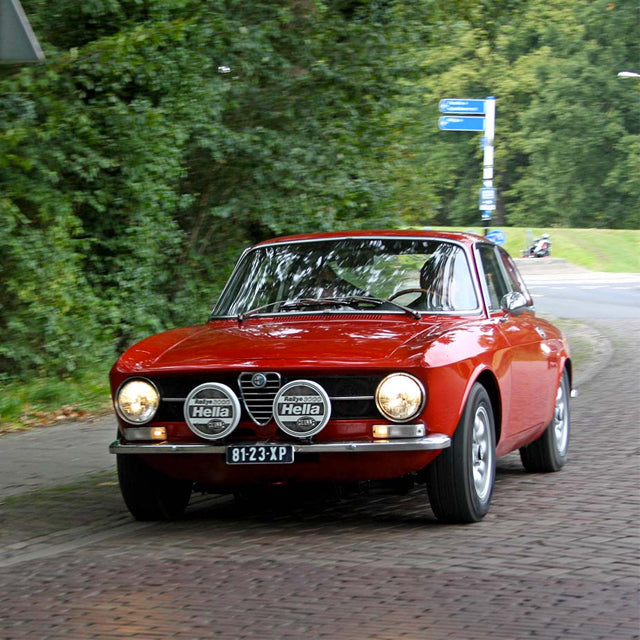Year, Make, and Model: 1973 Alfa Romeo Giulia GT Junior 1600
Location: The Netherlands
Photographers: Sebastiaan Bleuanus, Bob Verwiel Reclamefotografie, & alfaspeed.nl

Growing up around my mechanic dad, I was bound to end up being hooked on the things. An education as an automotive engineer followed, with lots of automotive adventures along the way. Well, I got married a few years ago and had a very similar car at the time that I later got rid of. After a long episode of very sensible “man maths” (what will not depreciate like a rock, fit the garage, have decent power (potential), low weight, and good looks?) the rational choice was made to buy a forty year old Alfa. Can’t beat a good bit of rational thinking, now can you? And as usual these days, I found the car while searching the internet. Whilst I still remember the good old days of rummaging through paper ads, no such romance was encountered here with this Alfa.
After buying the car last year, I set out to build a useable but classic-rally-ready fun car to replace the LSIS (Lotus Seven Inspired Roadster) I’d owned for eleven years before but that was, alas, lost during a classic winter rally on the slippery slopes of a mountain in the Czech Republic (more infohere ). That could be a story to run itself about a "young married couple taking on one of the hardest classic rallies in Europe as complete novices, crashing, and getting hooked in the process." Long story short: this Giulia is no trailer queen, but a nice driver fitted with full roll cage, fast road suspension, bucket seats, and full racing harnesses. I am currently in the process of building a mildly fettled 2000 engine for it.
There are also tales of rust, panel cutting and welding, painting, hunting down parts, and also of course the previously mentioned winter rally adventure. I’ve now also been in three rallies using the car; two shorter one-day events with an old schoolmate navigating and a longer one set in the south of Belgium, close to the French border. This latter one was the Belgian Westhoek Classic rally (http://www.belgianwesthoekclassic.be/). With my sister-in-law in the navigator seat (it was her very first time navigating), we set off as the very last car on Friday evening at around 21:33. At that point, it was already pitch-black outside and the additional Hella rally lights really came into their own when lighting up the surroundings. With a new-to-the-game navigator, a stellar performance was never in the cards, but we had decided that the main goal was to have fun. I must say that my sister-in-law really impressed me during the first leg of the rally. OK, we did make a few wrong turns, but overall we did pretty much OK. After around 210 kilometers, we reached the first refueling zone of the rally. After filling up the car we set off for the last 10km of the first leg, basically a short leisurely drive back to the main regroup for that evening. After 1.23 kilometers (as proven by the tripmaster): disaster! Without prior warning, the alternator light came on and the typical highly pitched screeching sound of a slipping fanbelt filled the cabin. We immediately parked the car to check out what was going on. After opening the bonnet (hood, for you Americans) it was pretty clear that the waterpump had crapped itself. Coolant was leaking out along its front seal and it was seized solid. It was the end of the rally for us….



Luckily, a local member of the voluntary fire brigade was just coming home, saw us on the side of the road and came over to have a chat and see what was wrong. He almost immediately offered us parking at his home and to take us to the hotel we had booked, some thirty minutes away. We decided then and there to park the car, get some sleep, and figure out how to deal with the issue in the morning.
Following a few phone calls the next morning, the decided course of action was to try and get a new waterpump, install it, and nurse the car back home. The guys of Goos van Pelt came to the rescue, having the right waterpump in stock. Only problem: it was 250km away. So what do you do in this kind of situation? Right: you call your retired dad! Without complaint, he jumped in the car, ferried the waterpump over to Belgium and we set about fitting it by the roadside. Within two hours (the flat-rate time for this repair is 2.5 hours), the new pump was on and all was looking well again. Briefly considering trying to rejoin the rally (there was still the last leg to go), we decided against that and made our way back home. This proved that the waterpump was the only casualty of the day; coolant and oil stayed nicely separated and at stable temperatures. The engine and head gasket had survived, likely because we noticed the failure straight away. How the waterpump could have failed without (audible) pre-warning will forever remain a mystery…..
Want to see your vintage car on Petrolicious?Click here for more information.





























































